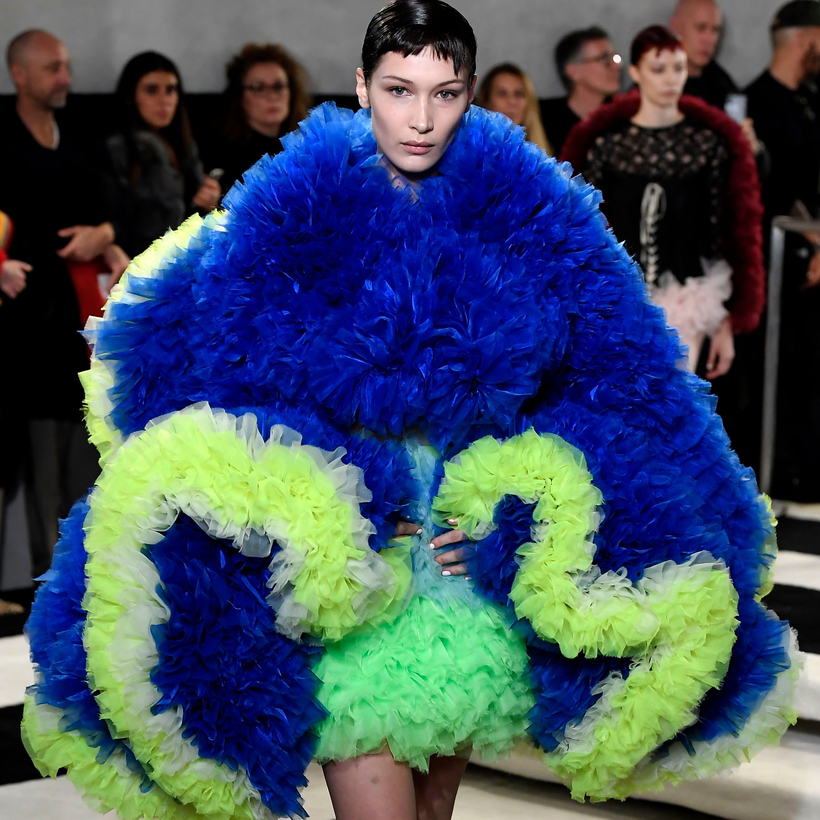One early morning in January, Tomo Koizumi was asleep in Tokyo when he received a text at three a.m.: “Literally, the best thing I’ve seen in years.” The sender was the super-stylist and Love magazine editor in chief Katie Grand, who has accrued the power to anoint designers or banish them to mid-market irrelevancy. She was referring to Koizumi’s dresses—outrageously ruffled confections in raspberry, Creamsicle, peppermint, pistachio—which she had discovered on Instagram after noticing a post about his work from her friend, the designer Giles Deacon.
Grand sensed an opportunity to create a bona-fide fashion moment, and she set to work producing a show for Koizumi during New York Fashion Week in February. She asked her longtime friend and creative collaborator, the designer Marc Jacobs, to borrow his Madison Avenue store for the venue, and enlisted Pat McGrath and Guido Palau to mastermind the makeup and hair, respectively, for the show. Anita Bitton, a casting agent and another Grand intimate, cast a lineup of top models, from Bella Hadid and Karen Elson to Joan Smalls.
Just one month after that introductory text, Koizumi was in New York, presenting his collection. He hadn’t priced the collection or secured a showroom. He didn’t even employ a full staff. “That show just happened,” says Koizumi. “I only focused on making things. I didn’t think about anything else.”
This unorthodox approach to showcasing a new collection, supported by some of the biggest names in the industry, had its intended effect. Requests from buyers, private clients, and the press poured in. “It was the biggest gift that I’ve ever had,” says Koizumi. “Of course, from Katie. But also from the world.”
Ruffled Armor
Today, back in Tokyo, he works out of his sister’s tiny living room. Although he studied art education and has a license to teach, he has spent the past eight years as a costume designer, creating elaborate pieces for major stars in Asia, including Japan’s pop supergroup Perfume, as well as Lady Gaga. His signature style involves cascades of Kool-Aid-colored ruffles. Each dress is machine-sewn, using up to 200 meters of Japanese polyester organza. He envisions his designs as ruffled armor, citing manga series Sailor Moon and the colorful Australian performance artist and costume designer Leigh Bowery as references. “Of course, I love feminine details, but I want to make something unique,” says Koizumi. “My kind of girl is not only cute but strong inside, so I want to express a person like that in my design.” Despite his newly minted membership to the upper echelons of fashion, he still considers himself a costume designer whose pieces are not destined for commercial consumption.

Koizumi’s breakout rise also illuminates the fashion industry’s evolution in the era of social media. Traditional, beautifully tailored clothes do not necessarily generate the most likes on Instagram. And so, accordingly, fashion has started seeing itself as a source of entertainment: shows increasingly resemble major theatrical productions, starring models who are now globally known personalities. To be noticed—and, ultimately, to make money—designers must do more than make beautiful clothes. They have to create an indelible moment that reverberates on Instagram.
Koizumi’s exuberant, voluminous dresses are nearly unwearable, and nobody seems to mind. “My clothes are eye-catchy, with bright colors—theatrical,” he explains. “That’s why people enjoy to watch it.” A few months after Koizumi had his first New York show, Andrew Bolton, the head curator of the Metropolitan Museum of Art’s Costume Institute, asked to include two of his dresses in the current “Camp: Notes on Fashion” exhibition. Most designers wait out their careers in hopes of receiving that nod. Koizumi was added so quickly that his pieces are not included in the monograph.
Meanwhile, Koizumi and Grand have been discussing getting the creative gang back together for a new kind of fashion presentation in September. No matter that he has yet to make a collection available for retail and find a factory to scale production. Koizumi will continue to do what he does best: make fun and fanciful dresses that generate like after like after like. “I really love this ruffle,” admits Koizumi. “I don’t make a tailored jacket.”
Whitney Vargas is a writer based in New York.

